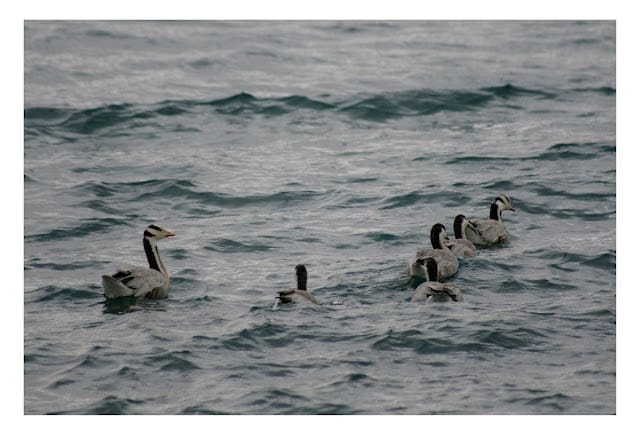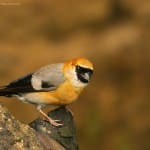Meeting the Bar-headed Goose, arguably the world’s highest flier, in its breeding grounds at 15,000 feet is a rare and humbling privilege
Korzok (4,595 m, 15,075 ft), the small settlement on the border of the incredibly blue Tso Moriri was the highest I had even been. So when had my first sighting of the Bar-headed Goose (Anser indicus), one of the highest flying birds in the world, on those very waters at a shouting distance from the 300-year old monastery, you can perhaps excuse me for believing that it was probably pre-ordained.
The lake, along with several other high altitude lakes and marshes of Ladakh (including the now popular Pongong Tso), is a breeding ground for this enigmatic goose whose simple diagnostic features are the black bars along the face. The first bar starts just behind its black eye giving it a very peculiar “eyeless” appearance when seen from a distance. The body is grey and it honks like rest of the goose family. The beak is yellow and the legs and feet are orange. The geese eat grasses along the lakes and are ground-nesters, laying a clutch of 3 to 7 eggs in a shallow, down-padded depression.
The Bar-headed Goose is probably the world’s highest flying bird. The birds have been observed flying over the peaks of the Great Himalayas (this is the Siberian population, not the one in Ladakh) and one estimate put the height of their migration flyway at over 10,000 m (33,000 ft). This would mean that they might even be taking advantage of jet streams for their migratory flights – probably the only bird known to do so. They have a flapping flight – not a soaring/gliding one – and adaptations like a large wing surface and haemoglobin capable of using the rarefied oxygen more efficiently. Following the jet stream cuts the needs for energy and enables one of the fastest migrations into India.
At Tso Moriri, I encountered them along the shore while walking along the lake. They saw me before I saw them and had started to walk down towards the water, chicks in tow, when I spotted them. There was no panic but they kept a watchful eye on me till they reached the lake. Then they gently swam away – a very gentle, effortless paddle, hardly appearing to move yet growing more and more distant while bobbing up and down along the wind-ruffled blue waters tinted with the silver of dawn.
Once winter grips the plateau in early October, the Bar-headed Geese will fly inland to Assam, northern India and right down to Tamil Nadu in peninsular India. Along the way, as they disperse, large congregations can sometimes be seen, and one of the birds’ favoured sites is the Pong Dam in Kangra (Himachal Pradesh) where upto 30,000 geese flock. They stay on till late April before heading back to their breeding grounds.
The lake, along with several other high altitude lakes and marshes of Ladakh (including the now popular Pongong Tso), is a breeding ground for this enigmatic goose whose simple diagnostic features are the black bars along the face. The first bar starts just behind its black eye giving it a very peculiar “eyeless” appearance when seen from a distance. The body is grey and it honks like rest of the goose family. The beak is yellow and the legs and feet are orange. The geese eat grasses along the lakes and are ground-nesters, laying a clutch of 3 to 7 eggs in a shallow, down-padded depression.
The Bar-headed Goose is probably the world’s highest flying bird. The birds have been observed flying over the peaks of the Great Himalayas (this is the Siberian population, not the one in Ladakh) and one estimate put the height of their migration flyway at over 10,000 m (33,000 ft). This would mean that they might even be taking advantage of jet streams for their migratory flights – probably the only bird known to do so. They have a flapping flight – not a soaring/gliding one – and adaptations like a large wing surface and haemoglobin capable of using the rarefied oxygen more efficiently. Following the jet stream cuts the needs for energy and enables one of the fastest migrations into India.
At Tso Moriri, I encountered them along the shore while walking along the lake. They saw me before I saw them and had started to walk down towards the water, chicks in tow, when I spotted them. There was no panic but they kept a watchful eye on me till they reached the lake. Then they gently swam away – a very gentle, effortless paddle, hardly appearing to move yet growing more and more distant while bobbing up and down along the wind-ruffled blue waters tinted with the silver of dawn.
Once winter grips the plateau in early October, the Bar-headed Geese will fly inland to Assam, northern India and right down to Tamil Nadu in peninsular India. Along the way, as they disperse, large congregations can sometimes be seen, and one of the birds’ favoured sites is the Pong Dam in Kangra (Himachal Pradesh) where upto 30,000 geese flock. They stay on till late April before heading back to their breeding grounds.
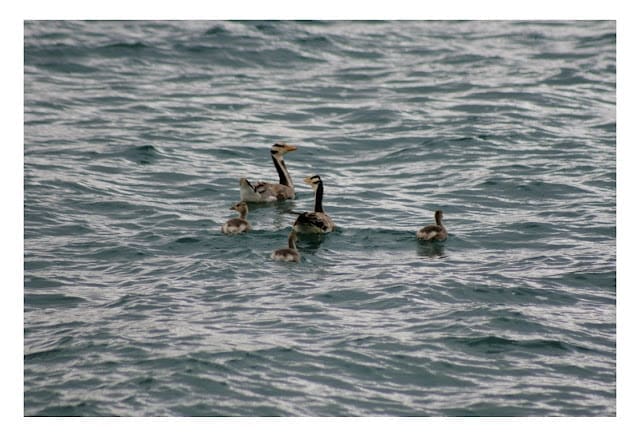 |
| Bar-headed Geese at home in Tso Moriri |
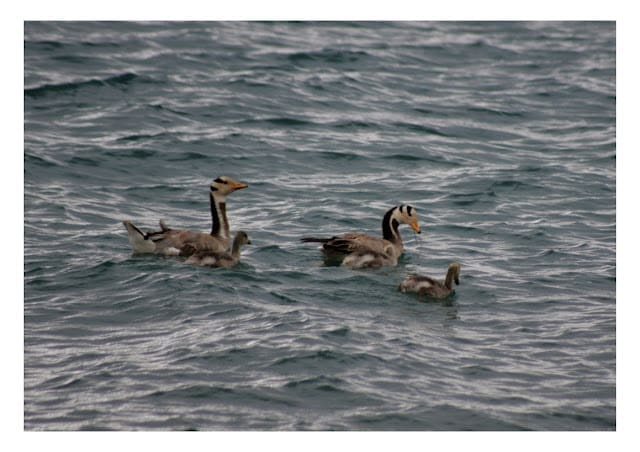 |
| The downy chicks take after their parents |
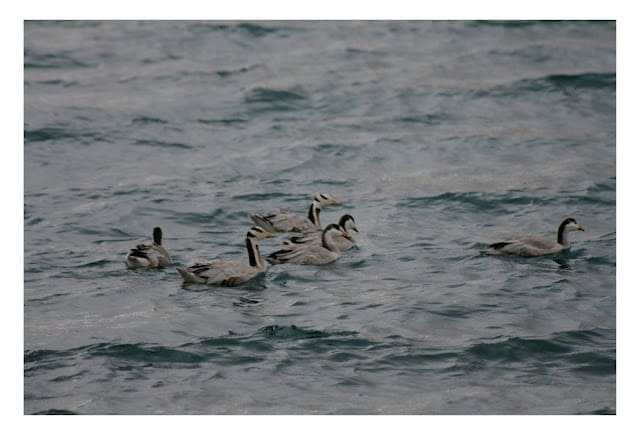 |
| A few fledged juveniles join the adults – note the darker napes of the juveniles |
Text and Photographs by Sahastrarashmi
Close up of the Bar-headed Goose from Wikipedia Commons
Latest posts by SR (see all)
- Encounter: The Sacred Grove at Oorani - November 28, 2012
- Encounter: Rhododendron, sentinel of the highlands - October 7, 2012
- Manjhi Akshayavat, an immortal Banyan tree - July 17, 2012


